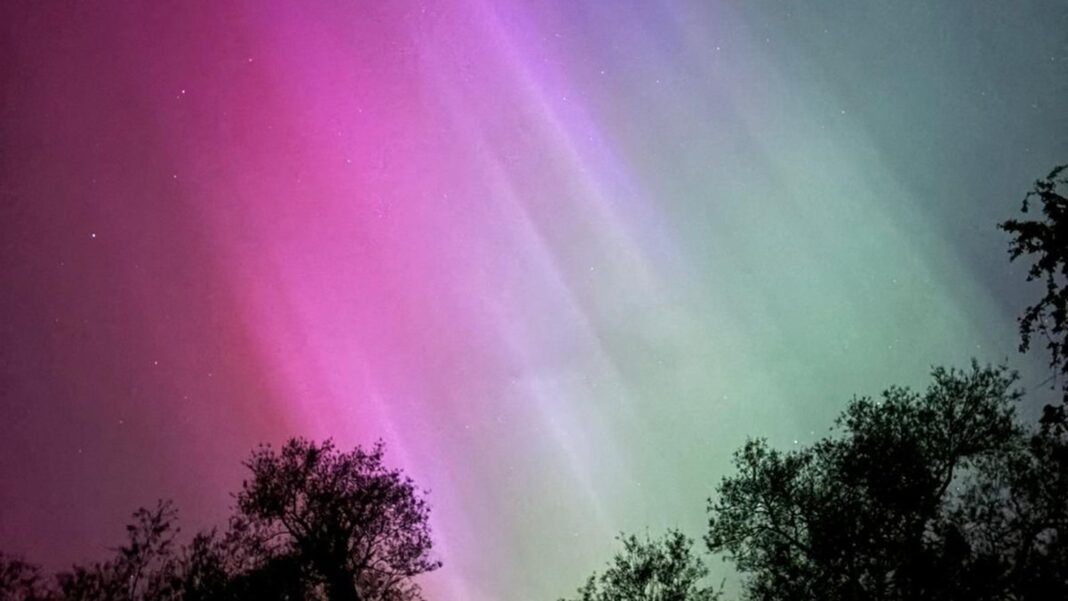The skies over the UK were lit up in a brilliant pink and green from the Northern Lights last night due to a severe solar storm.
The impressive Aurora Borealis, usually only visible from northern parts of the British Isles, was visible across large parts of the UK overnight, including Scotland, Wales, Northern Ireland and, unusually, southern England.
Scroll down to see some of the pictures from across the UK…
It comes after America’s National Oceanic and Atmospheric Administration (NOAA) issued its first severe solar storm warning since 2005 yesterday as a huge geomagnetic storm raced towards Earth.
Fears were also raised that the storm could interfere with infrastructure, including the power grid and satellites.
See the latest weather forecast where you are
This content is provided by X, which may be using cookies and other technologies.
To show you this content, we need your permission to use cookies.
You can use the buttons below to amend your preferences to enable X cookies or to allow those cookies just once.
You can change your settings at any time via the Privacy Options.
Unfortunately we have been unable to verify if you have consented to X cookies.
To view this content you can use the button below to allow X cookies for this session only.
The huge solar storm was created by successive coronal mass ejections (CMEs) that have left space a “mess”, one space physicist told Sky News.
CMEs are when a large cloud of high energy plasma erupts from the Sun, into space, and currently there is a sunspot spitting a number out – aimed right at Earth.
‘Space is a mess’
Professor Mathew Owens, a space physicist at the University of Reading’s department of meteorology, told Sky News: “Space is a mess right now, there’s six or seven of these eruptions piling up right now between the Sun and Earth and we’re predicting they’re going to arrive at 2am [11 May].”
Ahead of the event, the Met Office told Sky News: “With clear spells likely for many on Friday night, there’s an increased chance of aurora visibility for some, particularly across Scotland, Northern Ireland and parts of northern England and Wales.
“Given the right conditions, there is the chance it may even be visible further south.”
How to see the Northern Lights
The good news is that many places will have clear skies overnight and it’s not going to be too cold either.
The best chance of seeing the Northern Lights will be from Scotland and Northern Ireland, although the northern and western isles will be cloudier at times.
Parts of northern England and North Wales may also get lucky, especially if you can get onto higher ground away from the light pollution of the towns and cities.
It’s less likely you’ll see them further south, but not impossible.
It might sound obvious, but as well as clear and dark skies you need to look towards the northern horizon, so a north-facing coast is a great place.
And even if you can’t see much with your eyes, try using your smartphone or camera. Even better if you have a tripod and can set up a long exposure.
Interestingly, the solar flares will also boost UV levels. Something to watch out for over the next couple of days in the sunshine.
Read more from Sky News:
Plane skids off runway injuring at least 10 people
William gives update on Kate after cancer diagnosis
Professor Owens added: “The worry is there’ll be effects on the power grid. I don’t expect those to be significant but you never know.”
The NOAA says: “Geomagnetic storms can … potentially disrupt communications, the electric power grid, navigation, radio and satellite operations.”
Satellites are also vulnerable because they can be affected directly by radiation caused by CMEs, while power grids are affected because the solar discharge can warp the Earth’s own magnetic field, impacting them.
The solar flares and CMEs that have caused all the “mess” in space began on 8 May and picked up the pace in recent days.
The explosion of plasma and magnetic fields are focused in one sunspot that is actually visible from Earth and can be seen safely through a pair of eclipse glasses.
This content is provided by X, which may be using cookies and other technologies.
To show you this content, we need your permission to use cookies.
You can use the buttons below to amend your preferences to enable X cookies or to allow those cookies just once.
You can change your settings at any time via the Privacy Options.
Unfortunately we have been unable to verify if you have consented to X cookies.
To view this content you can use the button below to allow X cookies for this session only.

Keep up with all the latest news from the UK and around the world by following Sky News
It’s difficult to predict the precise impacts, or exactly how far south the Northern Lights will reach because of natural uncertainty within forecasts and the difficulty of measuring the oncoming electromagnetic fields of the eruptions too far ahead of time.
This gives them “very little warning” to the potential severity of the impacts.
A spokesperson for Energy Networks Association, which represents the UK’s electricity networks, told Sky News: “The energy industry plans for a range of events far and wide – including into space.
“We’re monitoring the space weather forecast carefully.”
Here are some of the best pictures we’ve received so far…

Shenley in Hertfordshire

Little Horsted, East Sussex. Pic: Max Coates

Great Malvern. Pic: Callum Welfare

Windsor

Salisbury. Pic: Elena Toms

High Wycombe

High Wycombe

Watford. Pic: Tom Carroll

Dorchester, Dorset. Pic: Sam Williams

Scotland. Pic: Sarah Mills

Bournemouth. Pic: Jamie Trowbridge

Somerton, north Oxfordshire

Watford

Northwood, north west London

Burnham, South Bucks

Hazlemere, Bucks

Southend, Essex

Cornwall

North Norfolk. Pic: Dave Rees







